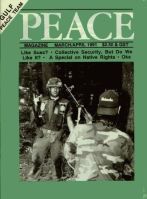
Peace Magazine Mar-Apr 1991, page 27. Some rights reserved.
Search for other articles by Dawn Hill here
The Lubicon are a small band of Cree in Northern Alberta. They have been struggling to settle their land claim for over fifty years. The Lubicon were missed when the government Indian agent signed treaty 8 with area Indian bands, in 1899. The Lubicon were recognized as a distinct band in 1939. The Indian agent C.P. Schmidt recommended a reserve be established between Little Buffalo and Lubicon Lake. This reserve has yet to be realized. Perhaps the federal government wavered when oil was discovered in the area around 1940.
In January 1989 the federal government offered a final take-it-or-leave-it deal, which the Lubicon refused to consider because it gave them no voice in area development or enough money to become self-sufficient. The $45 million dollar compensation would not begin to cover the expenses of building a new community in the Lubicon area. The Lubicon also shutdown oil wells operating in their area. At the same time the federal government poured over 500 million into the development of logging. Diashowa, a large Japanese Pulp and Paper Co., the main beneficiary of McKnight, completed their large plant in 1990.
To date approximately $400 million dollars per year has been extracted in oil from Lubicon land.
In 1988 Bill McKnight, minister of Indian Affairs was awarded the "Western Diversification Portfolio" by Prime Minister Brian Mulroney. Millions of federal dollars were poured into the oil and logging industry in Northern Alberta. Corporations such as Diashowa, Norcon, and Petro-Canada received grants worth millions by McKnight. Premier Donald Getty was quietly leasing out land in Northern Alberta the size of Great Britain. This included territory claimed by Lubicons. The Lubicon charged McKnight with "conflict of interest" since he was "supposed" to be the "trustee" of the Lubicon and all Natives. The Courts system stonewalled any attempts by the Lubicon to either settle the claim or stop the rapid development. They withdrew their 50 year old claim and erected a blockade to stop the oil and logging in their territory. Five days later the armed RCMP tore down their blockade and arrested 27 people. Two days later a deal was struck between Premier Getty and Chief Bernard Ominayak. the "Grimshaw Accord" promised the Lubicon a 95 square mile reserve and compensation. The federal government refused to sign or negotiate the terms in the Grimshaw Accord.
Diashowa had initially agreed to stay out of the Lubicon territory until the land claim was settled. However, in November of 1990 two logging companies contracted by Diashowa, began to log on lands claimed by the Lubicon. In fact, they started to log through Chief Ominayak's trap lines.
On November 24, Buchanan logging camp was mysteriously set afire. Approximately $20,000 worth of damage was done. Within days Little Buffalo was crawling with RCMP officers. Thirteen Lubicons were charged with arson, and minor offenses. Hector Whitehead claimed the RCMP prodded and frisked him during questioning. They also told him if he reported them, they would, "smoke him."
These Lubicons are charged are pleading "immunity." Their court dates are April 29, May 6, May 29. Ex-Chief Walter Whitehead (charged with arson, mischief) told me: "… even if they lock me up, lock all 13 of us up, they won't stop us, because we are right, and they're just puppets for politicians, doing their dirty work. My children will fight, and their children. They can't keep locking us up." (January 21, 1991)
The Lubicon Chief has requested those interested in supporting the Lubicon write: Premier Getty, Minister of Indian Affairs Tom Siddon, Diashowa, Petro-Canada, and P.M. Mulroney. For more information please write: Friends of the Lubicon, 94 Pinewood Ave. Toronto, Ont. M6C 2V1
Dawn Hill is a Six Nations Mohawk, and a Ph.D. Anthropology Candidate at McMaster University, corresponding from Little Buffalo, Alberta

Peace Magazine Mar-Apr 1991, page 27. Some rights reserved.
Search for other articles by Dawn Hill here